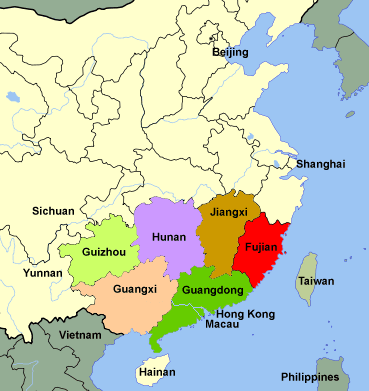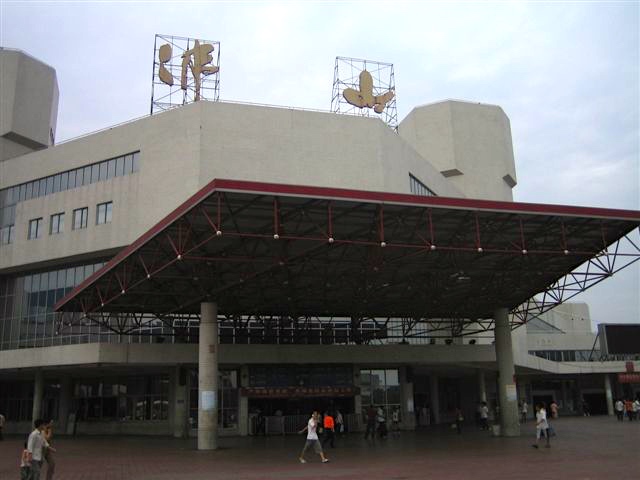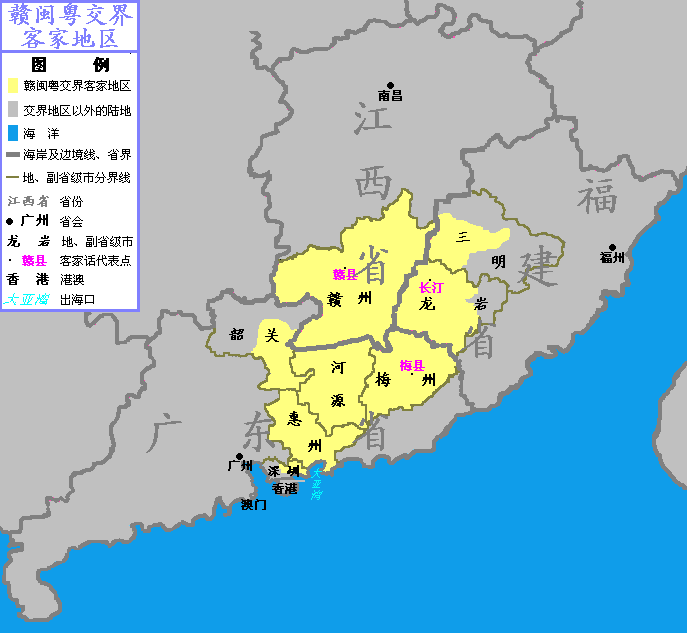|
Red Turban Rebellion (1854–1856)
The Red Turban Rebellion of 1854–1856 was a rebellion by members of the Tiandihui ( zh, c=天地會, Heaven and Earth Society) in the Guangdong province of South China. The initial core of the rebels were Tiandihui secret societies that were involved in both revolutionary activity and organised crime, such as prostitution, piracy, and opium smuggling. Many lodges were formed originally for self-defence in feuds between locals and migrants from neighboring provinces. They were organized into scattered local lodges, each under a lodge-master (堂主) and in October 1854 elected Li Wenmao and Chen Kai as joint alliance-masters (盟主). In Summer 1854, 50,000 outlaws, proclaiming a restoration of the Ming dynasty, captured Qingyuan. That roused the Tiandihui to revolt in the city of Conghua, forty miles northeast of the provincial capital. The Red Turbans were formed by religious members from Tiandihui, such as Qiu Ersao, who joined the Taiping Heavenly Kingdom with th ... [...More Info...] [...Related Items...] OR: [Wikipedia] [Google] [Baidu] |
Guangdong
) means "wide" or "vast", and has been associated with the region since the creation of Guang Prefecture in AD 226. The name "''Guang''" ultimately came from Guangxin ( zh, labels=no, first=t, t= , s=广信), an outpost established in Han dynasty near modern Wuzhou, whose name is a reference to an order by Emperor Wu of Han to "widely bestow favors and sow trust". Together, Guangdong and Guangxi are called ''Liangguang, Loeng gwong'' ( zh, labels=no, first=t, t=兩廣, s=两广 , p=liǎng guǎng) During the Song dynasty, the Two Guangs were formally separated as ''Guǎngnán Dōnglù'' ( zh, first=t, t=廣南東路, s=广南东路, l=East Circuit (administrative division), Circuit in Southern Guang , labels=no) and ''Guǎngnán Xīlù'' ( zh, first=t, t=廣南西路, s=广南西路, l=West Circuit (administrative division), Circuit in Southern Guang , labels=no), which became abbreviated as ''Guǎngdōng Lù'' ( zh, first=t, t=廣東路, s=广东路 , labels=no) and ''Guǎngxī Lù ... [...More Info...] [...Related Items...] OR: [Wikipedia] [Google] [Baidu] |
Xu Guangjin
Xu or XU may refer to: Surnames * Xu (surname 徐) ( ''Xú'') * Xu (surname 許) (/ ''Xǔ'') * Xu (surname 胥) ( ''Xū'') The tones of these surnames are different in Mandarin, but if the tone diacritics are omitted then each surname would be spelled Xu in pinyin, and Hsü in the Wade–Giles system or Hsu if the diaeresis is also omitted. People and characters * ǃXu, a name for the ǃKung group of Bushmen; may also refer to the ǃKung language or the ǃKung people * ǃXu (god), the creator god of the ǃKung * Xu, a minor character in the game ''Final Fantasy VIII'' Places * Xu (state) (), a state of ancient China in modern Jiangsu and Anhui * Xǔ (state) (), a state of ancient China in modern Henan Universities * X University (Toronto Metropolitan University aka Ryerson Polytechnic Institute), Toronto, Ontario, Canada * Xavier University (other) ** Xavier University in Cincinnati, United States ** Xavier University of Louisiana, United States * Xiamen Universit ... [...More Info...] [...Related Items...] OR: [Wikipedia] [Google] [Baidu] |
Guangxi Province
Guangxi,; officially the Guangxi Zhuang Autonomous Region, is an autonomous region of the People's Republic of China, located in South China and bordering Vietnam ( Hà Giang, Cao Bằng, Lạng Sơn, and Quảng Ninh Provinces) and the Gulf of Tonkin. Formerly a province, Guangxi became an autonomous region in 1958. Its current capital is Nanning. Guangxi's location, in mountainous terrain in the far south of China, has placed it on the frontier of Chinese civilization throughout much of Chinese history. The current name "Guang" means "expanse" and has been associated with the region since the creation of Guang Prefecture in 226 AD. It was given provincial level status during the Yuan dynasty, but even into the 20th century, it was considered an open, wild territory. The abbreviation of the region is zh, c = , labels = no (Hanyu pinyin: ; Zhuang: ), which comes from the name of the city of Guilin, the provincial capital during both the Ming and Qing dynasties. Guan ... [...More Info...] [...Related Items...] OR: [Wikipedia] [Google] [Baidu] |
Royal Navy
The Royal Navy (RN) is the naval warfare force of the United Kingdom. It is a component of His Majesty's Naval Service, and its officers hold their commissions from the King of the United Kingdom, King. Although warships were used by Kingdom of England, English and Kingdom of Scotland, Scottish kings from the early Middle Ages, medieval period, the first major maritime engagements were fought in the Hundred Years' War against Kingdom of France, France. The modern Royal Navy traces its origins to the English Navy of the early 16th century; the oldest of the British Armed Forces, UK's armed services, it is consequently known as the Senior Service. From the early 18th century until the World War II, Second World War, it was the world's most powerful navy. The Royal Navy played a key part in establishing and defending the British Empire, and four Imperial fortress colonies and a string of imperial bases and coaling stations secured the Royal Navy's ability to assert naval superior ... [...More Info...] [...Related Items...] OR: [Wikipedia] [Google] [Baidu] |
Guangzhou
Guangzhou, Chinese postal romanization, previously romanized as Canton or Kwangchow, is the Capital city, capital and largest city of Guangdong Provinces of China, province in South China, southern China. Located on the Pearl River about northwest of Hong Kong and north of Macau, Guangzhou has a history of over 2,200 years and was a major terminus of the Silk Road. The port of Guangzhou serves as a transportation hub for China's fourth largest city and surrounding areas, including Hong Kong. Guangzhou was captured by the United Kingdom, British during the First Opium War and no longer enjoyed a monopoly after the war; consequently it lost trade to other ports such as Hong Kong and Shanghai, but continued to serve as a major entrepôt. Following the Second Battle of Chuenpi in 1841, the Treaty of Nanking was signed between Robert Peel, Sir Robert Peel on behalf of Queen Victoria and Lin Zexu on behalf of Daoguang Emperor, Emperor Xuanzong and ceded British Hong Kong, Hong Kon ... [...More Info...] [...Related Items...] OR: [Wikipedia] [Google] [Baidu] |
Foshan
Foshan (, ; Chinese: 佛山) is a prefecture-level city in central Guangdong Province, China. The entire prefecture covers and had a population of 9,498,863 as of the 2020 census. The city is part of the western side of the Pearl River Delta megalopolis, a conurbation housing 86,100,000 inhabitants, making it the biggest urban area of the world. Foshan is regarded as the home of Cantonese opera, a genre of Chinese opera; Nanquan, a martial art; and lion dancing. Name ''Fóshān'' is the pinyin romanization of the city's Chinese name , based on its Mandarin pronunciation. The Postal Map spelling "Fatshan" derives from the same name's local Cantonese pronunciation. Other romanizations include Fat-shan and Fat-shun. Foshan means " BuddhaMountain" and, despite the more famous present-day statue of Guanyin (or Kwanyin) on Mount Xiqiao, who isn't a Buddha, it refers to a smaller hill near the centre of town where three bronze sculptures of Buddha were discovered in AD ... [...More Info...] [...Related Items...] OR: [Wikipedia] [Google] [Baidu] |
Dongguan
Dongguan,; pinyin: alternately romanized via Cantonese as Tungkun, is a prefecture-level city in central Guangdong Province, China. An important industrial city in the Pearl River Delta, Dongguan borders the provincial capital of Guangzhou to the north, Huizhou to the northeast, Shenzhen to the south, and the Pearl River to the west. It is part of the Pearl River Delta built-up (or metro) area with more than 65.57 million inhabitants as of the 2020 census spread over nine municipalities across an area of . Dongguan's city administration is considered especially progressive in seeking foreign direct investment. Dongguan ranks behind only Shenzhen, Shanghai and Suzhou in exports among Chinese cities, with $65.54 billion in shipments. It is also home to one of the world's largest shopping malls, the New South China Mall, [...More Info...] [...Related Items...] OR: [Wikipedia] [Google] [Baidu] |
Huizhou
Huizhou ( zh, c= ) is a city in east-central Guangdong Province, China, forty-three miles north of Hong Kong. Huizhou borders the provincial capital of Guangzhou to the west, Shenzhen and Dongguan to the southwest, Shaoguan to the north, Heyuan to the northeast, Shanwei to the east, and Daya Bay of the South China Sea to the south. As of the 2020 census, the city has about 6,042,852 inhabitants and is administered as a prefecture-level city. Huizhou's core metropolitan area, which is within Huicheng and Huiyang Districts, is home to around 2,090,578 inhabitants. History During the Song dynasty, Huizhou was a prefectural capital of the Huiyang prefecture and the cultural center of the region. The West Lake in Huizhou was formerly known as Feng Lake. At the age of 59, Su Shi was exiled to Huizhou by the imperial government of Song. When he visited Feng Lake in Huizhou, he found it located in the west of the city and was as beautiful as West Lake in Hangzhou. Therefore, he r ... [...More Info...] [...Related Items...] OR: [Wikipedia] [Google] [Baidu] |
Fujian
Fujian is a provinces of China, province in East China, southeastern China. Fujian is bordered by Zhejiang to the north, Jiangxi to the west, Guangdong to the south, and the Taiwan Strait to the east. Its capital is Fuzhou and its largest prefecture city by population is Quanzhou, with other notable cities including the port city of Xiamen and Zhangzhou. Fujian is located on the west coast of the Taiwan Strait as the closest province geographically and culturally to Taiwan; as a result of the Chinese Civil War, a small portion of historical Fujian is administered by Taiwan, romanized as Fuchien Province, Republic of China, Fuchien. While the population predominantly identifies as Han Chinese, Han, it is one of China's most culturally and linguistically diverse provinces. The dialects of the language group Min Chinese are most commonly spoken within the province, including the Fuzhou dialect and Eastern Min of Northeastern Fujian province and various Southern Min and Hokkien dial ... [...More Info...] [...Related Items...] OR: [Wikipedia] [Google] [Baidu] |
Small Swords Society
Small Swords Society or Small Sword Society was a political and military organisation active in Shanghai, China, and neighbouring areas amid the Taiping Rebellion, between about 1840 and 1855. Members of the society, rebelling against the Qing dynasty, occupied old Shanghai and many of the surrounding villages. Chinese gentry and merchants took refuge in the British and French concessions, which were regarded as the only safe places. The rebels briefly allied with the British and American forces in the concessions after Qing forces attacked the concessions during the Battle of Muddy Flat. The rebellion was suppressed and the society expelled from Shanghai in February 1855. History The organization was founded in 1850 during the upheavals leading to the Taiping Rebellion, its original leader being a Singaporean-born merchant with British citizenship, Chen Qingzhen (), in Xiamen, Fujian Province, many among its leadership also being English-speaking Singapore Chinese. It was one ... [...More Info...] [...Related Items...] OR: [Wikipedia] [Google] [Baidu] |
Nanjing
Nanjing or Nanking is the capital of Jiangsu, a province in East China. The city, which is located in the southwestern corner of the province, has 11 districts, an administrative area of , and a population of 9,423,400. Situated in the Yangtze River Delta, Nanjing has a prominent place in Chinese history and Chinese culture, culture, having served as the historical capitals of China, capital of various Dynasties in Chinese history, Chinese dynasties, kingdoms and republican governments dating from the 3rd century to 1949, and has thus long been a major center of culture, education, research, politics, economy, transport networks and tourism, being the home to Port of Nanjing, one of the world's largest inland ports. The city is also one of the fifteen sub-provincial city, sub-provincial cities in the People's Republic of China's Administrative divisions of the People's Republic of China, administrative structure, enjoying jurisdictional and economic autonomy only slightly les ... [...More Info...] [...Related Items...] OR: [Wikipedia] [Google] [Baidu] |








